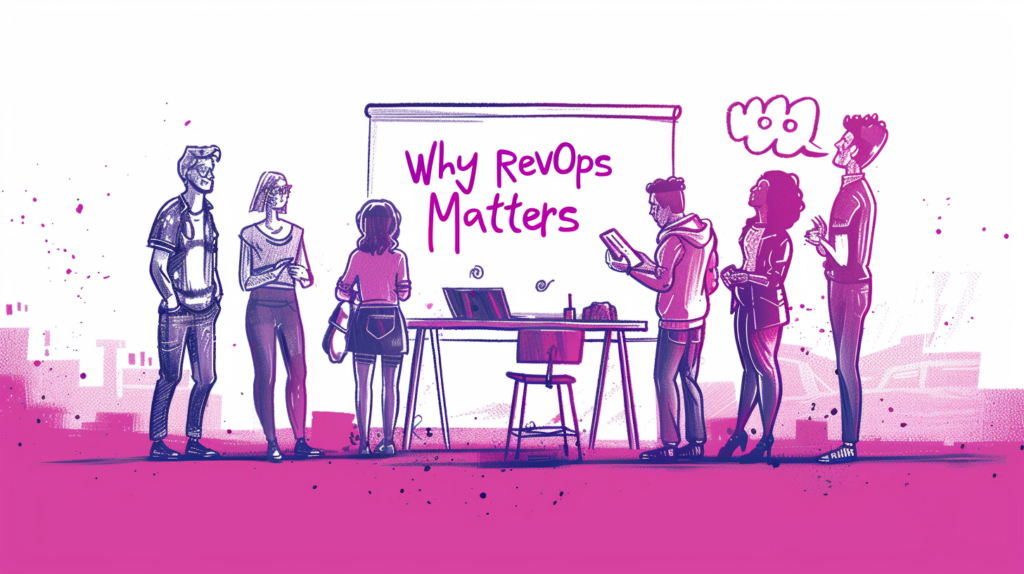


The SaaS Roadmap to an Effective RevOps Structure

Streamlining your Revenue Operations structure can feel challenging. Of course, you want to ensure that every part of your organization is aligned and moving in harmony toward achieving your revenue targets. But where do you start? And more importantly, how do you ensure that your efforts lead to tangible results?
Understanding Revenue Operations
Before we dive deep into the roadmap, let’s first unpack what revenue operations really mean. At its core, revenue operations (RevOps) is about breaking down silos between sales, marketing, and customer success teams. It’s about creating a unified approach to drive growth and streamline operations.
The Pillars of RevOps
RevOps stands on three main pillars: People, Process, and Technology. Each of these pillars plays a crucial role in ensuring the smooth operation of your revenue-generating activities.
People are at the heart of RevOps. It’s about ensuring that your teams are aligned, have clear communication channels, and are working towards the same goals.
Process involves mapping out the customer journey, from lead generation to closing a deal and beyond. It’s about understanding each step and optimizing it for efficiency and effectiveness.
Technology ties it all together. The right tools can automate tasks, provide valuable insights, and facilitate better decision-making.
Why RevOps Matters

In today’s competitive landscape, efficiency and alignment are key. Companies that have embraced RevOps have seen significant improvements in their operations. For instance, businesses report up to a 19% faster revenue growth and 15% higher profitability, according to recent studies.
But it’s not just about the numbers. RevOps also leads to better customer experiences, as teams are more synchronized and can address customer needs more effectively.
Building Your RevOps Strategy
Knowing the importance of RevOps is one thing, but implementing a strategy that works is another. Let’s explore how you can build a RevOps strategy that aligns with your business goals.
Assess Your Current State
Start by taking a close look at your current operations. Identify the gaps between your sales, marketing, and customer success teams. Are there communication breakdowns? Do your teams have access to the same data? Understanding where you are today is crucial for mapping out where you need to go.
Define Your Goals
What do you want to achieve with your RevOps strategy? Whether it’s increasing revenue, reducing customer churn, or improving operational efficiency, having clear goals will guide your efforts.
Remember, your goals should be SMART: Specific, Measurable, Achievable, Relevant, and Time-bound. This will help you track your progress and make adjustments as needed.
Align Your Teams
Alignment is the cornerstone of RevOps. Start by ensuring that your sales, marketing, and customer success teams have a shared understanding of your goals. Then, work on breaking down the silos. This might involve regular cross-functional meetings, shared KPIs, and integrated technology platforms.
Implement the Right Technology
Choosing the right technology stack is critical. Look for tools that offer integration capabilities, real-time data sharing, and analytics. CRM systems, marketing automation tools, and customer success platforms are just a few examples of the technology that can support your RevOps strategy.
Measuring Success

With your RevOps strategy in place, how do you know if it’s working?
There are hundreds of metrics and KPIs you can (and some you should) worry about on a daily basis. We wrote a more encompassing article on our top 15 to track here. But at its core, you need to worry about 3 things:
Revenue Growth
At the end of the day, RevOps is about driving revenue. Monitor your revenue growth closely. Are you seeing an uptick since implementing your RevOps strategy? This is a clear indicator of success.
Customer Lifetime Value (CLTV)
RevOps isn’t just about acquiring new customers; it’s also about retaining them. Keep an eye on your CLTV. An increase in this metric suggests that your customers are staying longer and are more valuable to your business.
Operational Efficiency
Look for improvements in operational efficiency. This could be in the form of reduced sales cycles, increased marketing campaign effectiveness, or improved customer support response times.
Enhancing Customer Engagement
One crucial aspect of a successful RevOps strategy is enhancing customer engagement. By focusing on building strong relationships with your customers, you can drive loyalty and advocacy, leading to increased retention and referrals.
Personalization is key in today’s competitive market. Tailoring your interactions with customers based on their preferences and behaviors can significantly impact their satisfaction and likelihood to continue doing business with you.
Utilize customer feedback to continuously improve your products and services. Actively seek input from your customers through surveys, reviews, and direct communication channels. This not only shows that you value their opinions but also provides valuable insights for enhancing your offerings.
Implementing a Customer Success Program
A robust customer success program is essential for ensuring that your clients achieve their desired outcomes while using your SaaS product. By proactively engaging with customers, understanding their goals, and providing ongoing support and guidance, you can increase their satisfaction and loyalty.
Offer educational resources, such as tutorials, webinars, and knowledge bases, to help customers maximize the value they get from your product. By empowering them with the necessary knowledge and skills, you can foster long-term relationships and drive advocacy within their networks.
Utilizing Data Analytics for Decision-Making
Data analytics plays a pivotal role in the success of a RevOps strategy. By leveraging data-driven insights, you can make informed decisions, optimize processes, and identify new opportunities for growth.
Implement robust analytics tools to track key performance indicators (KPIs) across your sales, marketing, and customer success functions. Analyze trends, patterns, and customer behaviors to uncover areas for improvement and innovation.
Utilize predictive analytics to forecast future trends and outcomes, enabling you to proactively address challenges and capitalize on emerging opportunities. By harnessing the power of data, you can stay ahead of the curve and drive sustainable growth for your SaaS business.
Enhancing Cross-Functional Collaboration
Effective cross-functional collaboration is essential for the success of a RevOps strategy. By fostering a culture of collaboration and knowledge-sharing across departments, you can break down silos, drive innovation, and deliver a seamless customer experience.
Encourage regular meetings and brainstorming sessions involving members from sales, marketing, customer success, and other relevant teams. By bringing diverse perspectives together, you can generate creative solutions, identify synergies, and align strategies towards common goals.
Utilize collaboration tools and platforms to facilitate communication and project management across teams. By creating a centralized hub for information sharing and collaboration, you can streamline processes, enhance transparency, and foster a culture of teamwork and accountability.